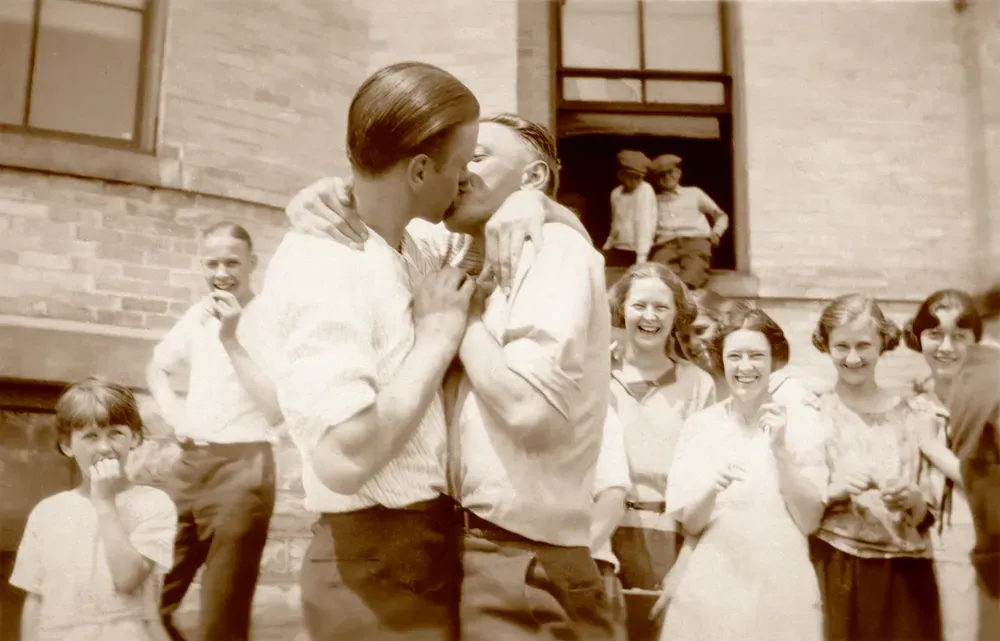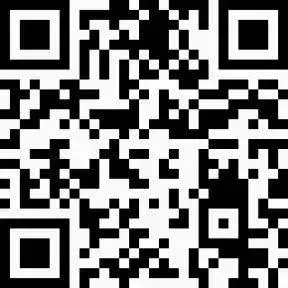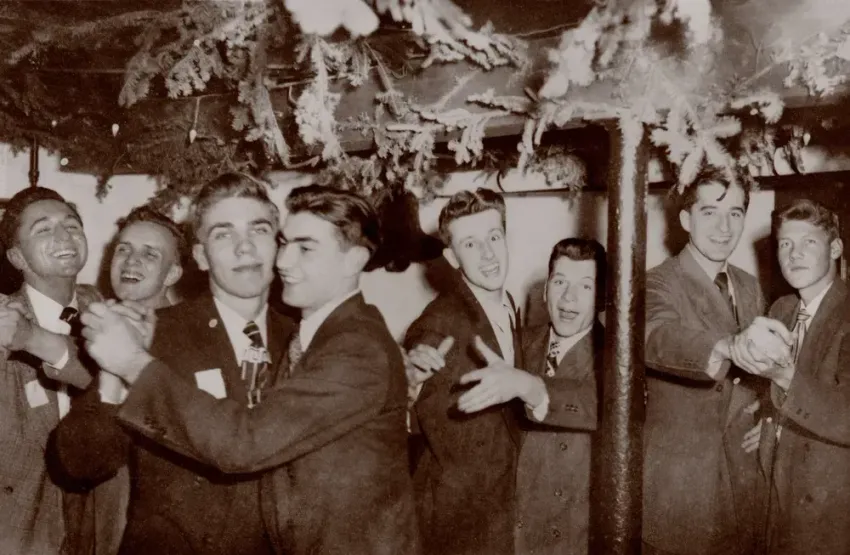In 2020, NYC-based Gay couple Neal Treadwell and Hugh Nini released Loving: A Photographic History of Men in Love, 1850s-1950s. As the first-known published collection of historical photographs depicting Gay couples, it received much acclaim globally.
Embarking again upon a labor of love and having collected more historical photographs around the US, the pair will follow this up with Loving II: More Photographic History of Men in Love, 1850s-1950s, which comes out October 14.
In preparation for this release, they agreed to answer some questions about the new book and their creative process with the SGN.
Madison Jones: There is an old adage that says: "A picture is worth a thousand words." How do you both feel about this sentiment, and in terms of the new book, does it hold true?
Hugh Nini: The old adage "a picture paints a thousand words" endures because it's true, doesn't it? When we found our first photo in the year 2000, it said so many things to us. It said, “You were never alone, we paved the way for you, we mattered to one another, and we wanted you to know that.” It said, “We've always been here and we've always loved each other.” It said, “We've cleared a path for you” and so, so, much more.
We'll be the first to admit that when we first published Loving in 2020, even we didn't understand all of the words and messages contained in these photographs. Every day we receive messages from people who tell us what our books say to them. Or as you put it, the thousand words that tell the millions of stories of who these couples were and what they mean today. It has been a process of discovery for us too.
Regarding our new book, it continues, and broadens, the message of our first, that of romantic love between two men during the hundred-year period between the 1850s and 1950s.

MJ: It has been five years since you both released Loving. What inspired you both to release another edition, and was the process of creating the new book in any way different from the first?
HN: There was always talk of a second book since we published our first in 2020. It was supposed to launch in 2021, then '22, then ‘23, and then '24. We had to hold off because the first Loving was still doing well and our publisher warned us that going too soon with a second would "step on it."
The inspiration for publishing Loving II came from the same source as our first book: the couples in our photographs. They all want and deserve a voice. But with over 4,000 photographs, it's not likely we'll be able to hear from everyone. With a second book, though, we can at least present another 300+ images.
The photos in book two are as emotional as those in our first Loving — in some cases more. We had great anxiety over whether or not it was possible to publish a second book that would be as powerful as our first. Now that it's done, at least to us, it seems at least as powerful as the first. Possibly more.
The double page on pages 174–175 is breathtaking. It shows two teenaged boys kissing in front of their school with other students looking on, smiling and clapping. It was taken on May 29, 1923.
As for the creative process for Loving II, it was slightly different than with Loving I. With our first book, we were determined to keep the message of our collection laser-focused: that of romantic love between two men. We didn't want to deviate, even slightly, out of concern for the message of our collection getting confused.
With Loving II, we deviated, slightly. In our new book, we present a few images that are romantic but also a little sexual. Or "frisky," as we like to call them. Another deviation is couples who hid their faces [out of] concern for their safety. Another is photographs where one or both of the men present as female. Our Trans brothers and sisters are topics of intense debate today, much like Gay people have been for the last 50-plus years. But no one has really referred to them as having been around since the 1860s, as our collection demonstrates.
The last deviation we made was to include inscriptions on either the front or back of some photographs. One that comes to mind is on the back of a photo taken around 1910. It reads: "Dandy Uncle Declan and his boy homosexual." It was obviously taken by a relative of Declan who recognized him as one half of a relationship. The word "homosexual" was the available term he or she had for what his lover was. It comes off as completely nonoffensive.
One inscription that we wanted to include but didn't had alterations of the faces in the photograph (devil horns and goatees), and writing on the back that demonstrated a very unhappy breakup. It's so interesting, because breakups are part of the story of some relationships, but we didn't want to break the romantic spell of the rest of the book. But who knows? Like us, they might have gotten back together. We'll probably take that one to our speaking engagements!

MJ: In a documentary [on your website], it mentions you both found your first photo of a male couple at an antique mall in Dallas. As Texan transplants in New York City, do you visit back home often? And is there anything you miss about living in Dallas and the LGBTQ+ community there?
HN: We were together on that trip to the antique mall in Dallas, but it was actually Neal who found that first photo there, jumbled in a box of otherwise nondescript photos.
We absolutely love our lives here in NYC, but we do miss our home in Dallas, and we still have tons of friends there, as well as our families. So, yes, we do go back as often as possible. We were in Houston just last month, visiting our 96 year-old mother/mother-in-law and a sibling. And we had a wonderful home in Dallas that we'll never finish grieving. When we're in town we always drive by it.
Having both been born and raised in Texas, we left a lot behind to move here. Our ties to Texas are deep and will remain forever, even though its politics have drifted further and further away from us.
MJ: These last few years, there has been a movement to ban LGBTQ+ books in schools and libraries across the country. Why do you both think people react so strongly when confronted with such history and stories?
HN: It hasn't just been the last few years, unfortunately, although it certainly has ticked up recently, and that can be directly linked to the Christian nationalist movement's increasing influence with the Trump administration.
When we lived in Dallas, we belonged to a wonderful nondenominational Christian church, Cathedral of Hope, for 18 years until we moved to NYC. It also happened to be the largest, predominantly LGBTQ+ church in the world, with a membership that numbers in the thousands. It embraced the teachings of Jesus: love, kindness, helping the poor, loving and caring for the sick, treating others as you would have them treat you, that we are all equal in God's eyes, and more.
In the aggregate, though, opposition to LGBTQ+ people has always had its roots in mainline religion first and politics second. There are great churches here and there, like ours in Dallas, that don't embrace this hatred, as well as an entire political party that doesn't. But there is another side who funds and populates a vast faction that we call the "anti-LGBTQ+ industrial complex," who essentially recognize only one book. Guess which one...
And they want to destroy everything, including books, that they see as being in conflict with their one book. This kind of hateful religiosity is holding the world back and causing a lot of suffering, in particular for us.
So, yes, they ban books, burn books, but worse, they shun and exile their own children, the children that they are supposed to be protecting and caring for. LGBTQ+ people are born to everyone, including homophobes, sadly. They choose their book, which they altered in the 1940s to add homophobic passages that weren't there before, over their own children. It's heartbreaking.
MJ: Final question: If you both could go back in time and meet some of the male couples in these photographs, what would you say to them? And vice versa: what do you think they'd say if they traveled to our current day?
HN: We actually addressed the latter part of your question at our exhibition at the Rath Museum in Switzerland in 2023. We spoke at the opening to a wall-to-wall crowd that was filled with every kind of face you can imagine: LGBTQ+, straight, children, all races, everyone.
As for what we said, it went something like this: "Standing here today at this museum opening, we can't help but imagine that all of these beautiful men are looking down on us from above in wonderment, and thinking, or saying to one another, 'My God... Who would have ever thought that the little photograph that we took of ourselves, and then kept hidden for its very survival, would end up as an exhibition in a prominent museum — and that people would be weeping over it?’ And the force of goodness might have replied, ‘I knew. But I never told you because you would have never believed me.’"
As for what we would say to these men, these couples, if we could go back in time? It's simple. "It gets better. We will always need to fight, but it gets better."
Loving II: More Photographic History of Men in Love, 1850s-1950s comes out on October 14. Signed and limited edition copies are available for pre-order at https://www.loving1000.org/ as well as https://bookshop.org/
Support the Seattle Gay News: Celebrate 51 Years with Us!
As the third-oldest LGBTQIA+ newspaper in the United States, the Seattle Gay News (SGN) has been a vital independent source of news and entertainment for Seattle and the Pacific Northwest since 1974.
As we celebrate our 51st year, we need your support to continue our mission.
A monthly contribution will ensure that SGN remains a beacon of truth and a virtual gathering place for community dialogue.
Help us keep printing and providing a platform for LGBTQIA+ voices.
How you can donate!
Using this link: givebutter.com/6lZnDB
Text “SGN” to 53-555
Or Scan the QR code below!



